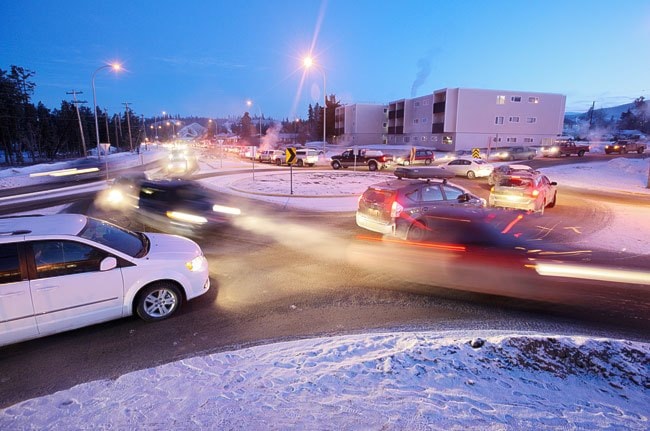Whitehorse is home to some uncommonly bad drivers. This fact is underlined by the city’s recent efforts to improve the public’s understanding of the much-maligned roundabout.
The rules for navigating a roundabout are fairly simple: drivers entering the circle must yield, while those within the circle have right of way. Signal as you leave the circle. Really, that’s it.
Yet Whitehorse’s roundabouts are the sites of much confusion, as illustrated by our article in Wednesday’s edition.
Some drivers entering a circle blast right through, failing to yield to those with the right of way. Alternately, drivers within the circle pull to a stop and yield when it’s their turn to go.
In extreme cases, a confused tourist has been seen driving a roundabout in the opposite direction. Or, in one notorious example, a city bus driver plowed straight through a roundabout, apparently forgetting it was there. But the big reason why roundabouts see so much congestion is because of confusion over who yields and who goes.
A variety of forces appear to be at work. Some commuters along Riverdale’s Lewes Boulevard fancy themselves to be gunning down the Alaska Highway, and have trouble imagining that they don’t possess the right of way when they hit the circle on the corner with Nisutlin Road, despite the yield signs indicating as much.
Others, meanwhile, are under the impression that drivers are supposed to take turns proceeding.
There’s also the small-town impulse to show a bit of friendliness and wave other traffic through. This cordiality was actually needed in Riverdale before the city installed the traffic circle and the lights at Hospital Road, otherwise cars turning left from a side road would have been stuck until the morning traffic subsided. But at a roundabout, such gestures only create a confusing impasse in which nobody knows whose turn it is to go.
Some drivers have even learned the rules backward, but have no knowledge of this and remain adamant they are driving the right way. We queried our readers on Facebook earlier this week about their roundabout frustrations, and one respondent described at great length how she would nose into the roundabout, expecting those inside the circle to yield to her. She couldn’t understand why she kept encountering upset drivers giving her the finger.
Roundabouts are a sufficiently emotional issue that, during the last municipal election, one unsuccessful candidate for mayor pledged to pave them over and install more traffic lights. But, to borrow a line from gun enthusiasts, roundabouts don’t cause accidents. People do.
Indeed, a raft of studies have found that when roundabouts are built in place of traffic lights at intersections, they result in fewer accidents. And because traffic moves more slowly in a roundabout than an intersection - where the tendency is to speed up to make a light - what accidents that do occur are less serious.
Roundabouts tend to be particularly unpopular with seniors. Yet they are the most likely to benefit from them, as elderly drivers are the most likely to face an accident in an intersection, often due to failing to obey the right of way, according to the U.S.‘s Insurance Institute for Highway Safety.
Roundabouts also tend to reduce pollution, because fewer vehicles are left idling at a stop. And they’re cheaper to build than traffic lights.
Roundabouts should even get everyone to their destination sooner, provided that drivers know how to use them. Studies by the IIHS in three states consistently found that roundabouts reduced traffic congestion when they were built in place of intersections.
But all of this is premised on the idea that people know how to navigate roundabouts. In Whitehorse, too often that isn’t the case.
A variety of solutions have been promoted. People want a new bridge out of Riverdale, or roundabouts far bigger in size, or fancier signage. At the end of the day, we suspect the city’s education campaign is probably the most appropriate approach.
Maybe this is overly optimistic, but it shouldn’t be beyond the ability of Yukoners to learn how to obey a yield sign. It’s certainly the most cost-effective approach. The city’s encouragement of residents to take the bus, walk or bike, or to ask employers to allow them to start and end work at off-peak periods, are all similarly sensible.
Maybe it’s also worth keeping in mind the broader picture. Some Yukoners seem to fly into a blind rage if they end up stuck in traffic for, say, 10 minutes. The next time you face a similar inconvenience, try to spend a moment reflecting on the many poor souls who waste a good slice of their lives crawling up and down Toronto’s Highway 401, and count your blessings. This is just one of many small ways in which Yukoners often forget how lucky they are. (JT)
